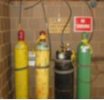
OSHA Amends Acetylene Standard, Issues Final Rule
OSHA has revised its acetylene standard. The agency said its new final rule replaces references to outdated industry standards with updated references reflecting current industry practices.
The revised standard requires that in-plant transfer, handling, storage, and use of acetylene cylinders comply with Compressed Gas Association Pamphlet G-1-2003, titled Acetylene. The revised standard also updates references for the provisions addressing piping systems, as well as acetylene generators and filling acetylene cylinders.
Acetylene is a colorless gas that can become explosive if liquefied, heated, compressed, or mixed with air. It is commonly used in certain plastics and is the most common gas used for fueling cutting torches. When mixed with pure oxygen in a cutting torch assembly, an acetylene flame can reach a temperature of 5,700 degrees F.
According to the MSHA Web site, use of acetylene creates special hazards in a workplace compared to other fuel gases. For example, the gas is chemically unstable, which makes it very sensitive to conditions such as excess pressure, excess temperature, static electricity, or mechanical shock. Exposure to any of these conditions can cause it to undergo a violent, explosive decomposition reaction. If this reaction or ignition occurs within the torch base or supply hose, it can propagate back into the storage cylinder causing it to explode violently. Acetylene is very easy to ignite and burns at a very fast rate, MSHA further notes. The energy from a static spark capable of igniting acetylene is lower than for any other fuel gas except hydrogen. The static charge developed by walking across a carpet floor on a dry day can be 1,700 times greater than that needed to ignite acetylene. When unburned acetylene gas is discharged from a torch, static electricity can be generated at the torch tip. If the tip comes in contact with a ground path, a static spark capable of igniting the gas can occur.
OSHA's direct final ruling on its acetylene standard stated that it would become effective on Nov. 9, 2009, unless the agency received no significant adverse comments on the direct final rule by Sept. 10, 2009. OSHA received eight comments on the direct final rule by that date, which the agency determined were not significant adverse comments. Therefore, OSHA is confirming that the direct final rule became effective on Nov. 9, 2009.
One of the eight comments OSHA received expressed concern that the agency would apply retroactively to existing acetylene-generating facilities that were compliant with the appropriate standards when originally constructed, those sections of the NFPA 51A-2001 standard that address site location, design, and materials (Ex. OSHA-2008-0034-0019). The commenter noted that applying the updated NFPA standard in this fashion would require moving or demolishing the facilities, or discontinuing operations. In response to that comment, OSHA noted that section 1.2.2 of NFPA 51A-2001 states,
"An existing plant that is not in strict compliance with the provisions of this standard shall be permitted to continue operations where such use does not constitute a distinct hazard to life or adjoining property." OSHA said this provision indicates clearly that NFPA 51A-2001 does not apply to acetylene plants in existence prior to publication of the standard when the operations in these plants do not endanger employees. Therefore, OSHA considers acetylene plants in existence prior to the effective date of NFPA 51A-2001 (i.e., Feb. 9, 2001) to be in compliance with that standard when the acetylene operations in these plants do not "constitute a distinct hazard" to employees.
Several of the other comments OSHA received observed that the Compressed Gas Association updated the CGA G-1 standard this year, and recommended that OSHA adopt this new edition (Exs. OSHA-2008-0034-0017, -0010, and -0022). OSHA said it did not include the 2009 edition of CGA G-1 in the direct final rule because that edition was not made available to OSHA prior to publication of the direct final rule, and, therefore, was beyond the scope of this latest rulemaking. In its comments, the Compressed Gas Association noted that the only difference between the 2003 edition referenced in the direct final rule and the recently issued 2009 edition is the addition of one sentence to a note in section 5.2 of the 2009 edition, which reads, "Additionally, single cylinders of acetylene and oxygen located at a work station (e.g., chained to a wall or building column or secured to a cart) shall be considered 'in service' " (see Ex. OSHA-2008-0034-0020). Nevertheless, OSHA said it plans to update the reference to CGA G-1 in a future rulemaking as resources and priorities permit.